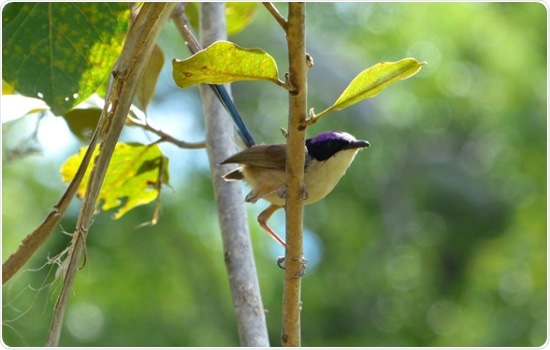A study led by Monash scientists has found the iconic Purple-crowned fairy-wren may hold the key to better understanding immune function.

Researchers measured the constitutive levels of immune function of wild purple-crowned fairy-wrens over five years and assessed the immune function related to fitness outcomes by monitoring subsequent survival. Credit: Mehdi Khadraoui
The long-term study, which took place at Mornington Wildlife Sanctuary operated by collaborator Australian Wildlife Conservancy (AWC) is published today in the Proceedings of the Royal Society B.
Maintaining constitutive immune function (immune surveillance) is important for individuals to be prepared for new infections, but is potentially costly to the individual.
Dr Michael Roast, Lead study author, Monash University School of Biological Sciences
“These costs can’t be measured using experimental methods that introduce immune challenges,” he said.
“But in a wild bird population we were able to measure individual levels of immune function and assess how this relates to fitness by monitoring subsequent individual survival, acquisition of dominant breeder positions, and reproductive success.”
It turns out that constitutive immune function doesn’t cost the individual that much.
“We observed different immune investment strategies were related to high survival, which might reflect a dynamic disease environment,” Dr Roast said.
Purple-crowned fairy-wrens (Malurus coronatus coronatus) are endangered Australian endemic birds that live in family groups year-round occupying the same territory along rivers and creeks of the tropical savannah.
The scientists focused on a core study population of the birds at Mornington Wildlife Sanctuary which had been color banded since 2005.
In this habitat, purple-crowned fairy-wrens are exposed to a variety of parasites with recorded infections.
The researchers measured the constitutive levels of immune function among individuals in the wild purple-crowned fairy-wren population over five years and assessed how these measures of immune function related to fitness outcomes by monitoring subsequent individual survival, acquisition of dominant breeder positions, and reproductive success.
We did not find any evidence of a trade-off between constitutive immune function and reproduction, which might be expected if individuals with finite resources are forced to invest in either immune function or reproduction. Instead, differences between individuals might be more important if high quality individuals are able to acquire breeding positions and can invest in both reproduction and immune function.”
Dr Michael Roast
The study was funded by BirdLife Australia and the Holsworth Wildlife Research Endowment (to M.J.R.), the Australian Research Council and the Max Planck Society.